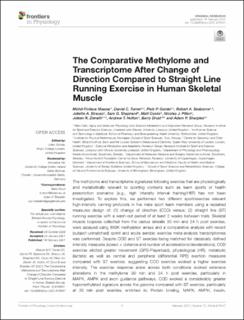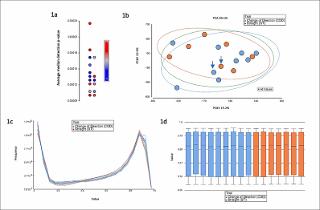| dc.contributor.author | Massar, Mohd Firdaus | |
| dc.contributor.author | Turner, Daniel C. | |
| dc.contributor.author | Gorski, Piotr Patryk | |
| dc.contributor.author | Seaborne, Robert A. | |
| dc.contributor.author | Strauss, Juliette A. | |
| dc.contributor.author | Shepherd, Sam O. | |
| dc.contributor.author | Cocks, Matt | |
| dc.contributor.author | Zierath, Juleen R. | |
| dc.contributor.author | Drust, Barry | |
| dc.contributor.author | Pillon, Nicolas J. | |
| dc.contributor.author | Hulton, Andrew T. | |
| dc.contributor.author | Sharples, Adam P. | |
| dc.date.accessioned | 2021-12-10T12:38:24Z | |
| dc.date.available | 2021-12-10T12:38:24Z | |
| dc.date.created | 2020-10-14T12:28:55Z | |
| dc.date.issued | 2021 | |
| dc.identifier.citation | Frontiers in Physiology. 2021, 12(2021), Artikkel 619447. | en_US |
| dc.identifier.issn | 1664-042X | |
| dc.identifier.uri | https://hdl.handle.net/11250/2833802 | |
| dc.description | This is an open-access article distributed under the terms of the Creative Commons Attribution License (CC BY). The use, distribution or reproduction in other forums is permitted, provided the original author(s) and the copyright owner(s) are credited and that the original publication in this journal is cited, in accordance with accepted academic practice. No use, distribution or reproduction is permitted which does not comply with these terms. | en_US |
| dc.description.abstract | The methylome and transcriptome signatures following exercise that are physiologically and metabolically relevant to sporting contexts such as team sports or health prescription scenarios (e.g., high intensity interval training/HIIT) has not been investigated. To explore this, we performed two different sport/exercise relevant high-intensity running protocols in five male sport team members using a repeated measures design of: (1) change of direction (COD) versus; (2) straight line (ST) running exercise with a wash-out period of at least 2 weeks between trials. Skeletal muscle biopsies collected from the vastus lateralis 30 min and 24 h post exercise, were assayed using 850K methylation arrays and a comparative analysis with recent (subject-unmatched) sprint and acute aerobic exercise meta-analysis transcriptomes was performed. Despite COD and ST exercise being matched for classically defined intensity measures (speed distance and number of accelerations/decelerations), COD exercise elicited greater movement (GPS-Playerload), physiological (HR), metabolic (lactate) as well as central and peripheral (differential RPE) exertion measures compared with ST exercise, suggesting COD exercise evoked a higher exercise intensity. The exercise response alone across both conditions evoked extensive alterations in the methylome 30 min and 24 h post exercise, particularly in MAPK, AMPK and axon guidance pathways. COD evoked a considerably greater hypomethylated signature across the genome compared with ST exercise, particularly at 30 min post exercise, enriched in: Protein binding, MAPK, AMPK, insulin, and axon guidance pathways. Comparative methylome analysis with sprint running transcriptomes identified considerable overlap, with 49% of genes that were altered at the expression level also differentially methylated after COD exercise. After differential methylated region analysis, we observed that VEGFA and its downstream nuclear transcription factor, NR4A1 had enriched hypomethylation within their promoter regions. VEGFA and NR4A1 were also significantly upregulated in the sprint transcriptome and meta-analysis of exercise transcriptomes.We also confirmed increased gene expression of VEGFA, and considerably larger increases in the expression of canonical metabolic genes PPARGC1A (that encodes PGC1-a) and NR4A3 in COD vs. ST exercise. Overall, we demonstrate that increased physiological/metabolic load via COD exercise in human skeletal muscle evokes considerable epigenetic modifications that are associated with changes in expression of genes responsible for adaptation to exercise. | en_US |
| dc.language.iso | eng | en_US |
| dc.subject | AMPK | en_US |
| dc.subject | change of direction | en_US |
| dc.subject | DNA methylation | en_US |
| dc.subject | MAPK | en_US |
| dc.subject | NR4A1 (Nur77) | en_US |
| dc.subject | NR4A3 | en_US |
| dc.subject | PGC1 alpha | en_US |
| dc.subject | VEGF | en_US |
| dc.title | The comparative methylome and transcriptome after change of direction compared to straight line running exercise in human skeletal muscle | en_US |
| dc.type | Peer reviewed | en_US |
| dc.type | Journal article | en_US |
| dc.description.version | publishedVersion | en_US |
| dc.rights.holder | © 2021 Maasar, Turner, Gorski, Seaborne, Strauss, Shepherd, Cocks, Pillon, Zierath, Hulton, Drust and Sharples | en_US |
| dc.source.pagenumber | 17 | en_US |
| dc.source.volume | 12 | en_US |
| dc.source.journal | Frontiers in Physiology | en_US |
| dc.identifier.doi | 10.3389/fphys.2021.619447 | |
| dc.identifier.cristin | 1839508 | |
| dc.description.localcode | Institutt for fysisk prestasjonsevne / Department of Physical Performance | en_US |
| dc.source.articlenumber | 619447 | en_US |
| cristin.ispublished | true | |
| cristin.fulltext | original | |
| cristin.qualitycode | 1 | |

